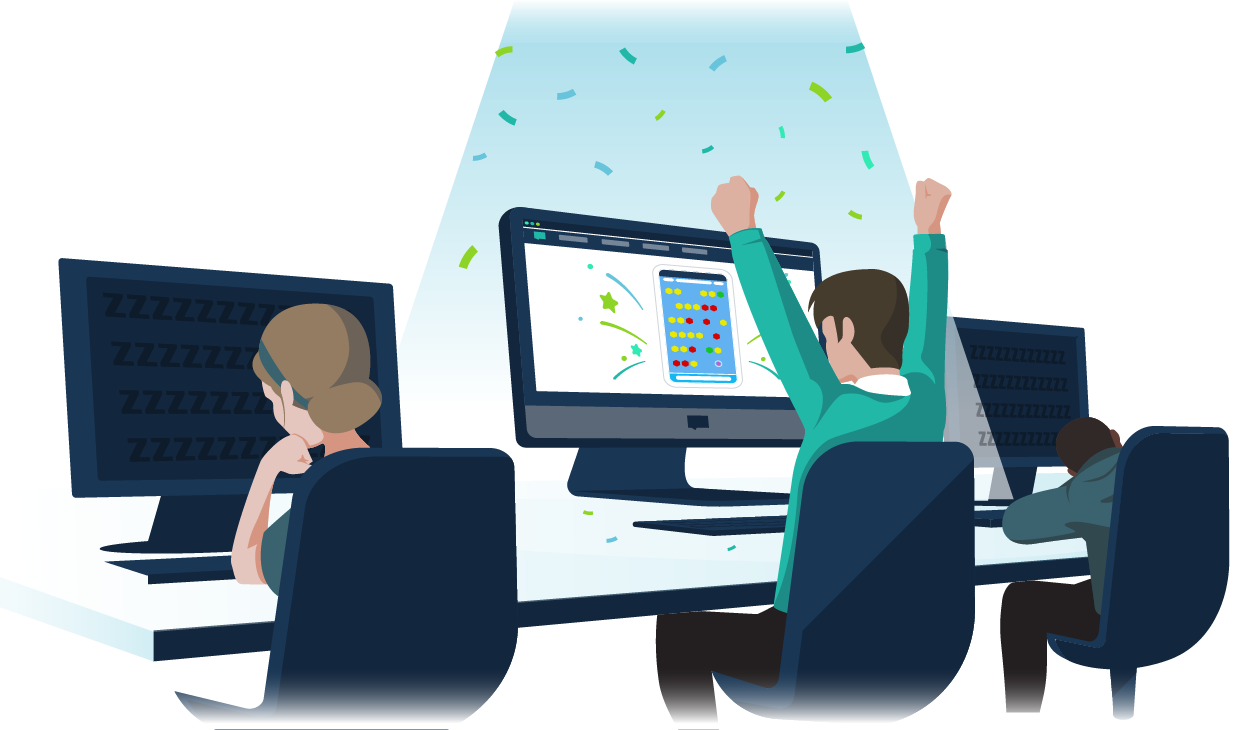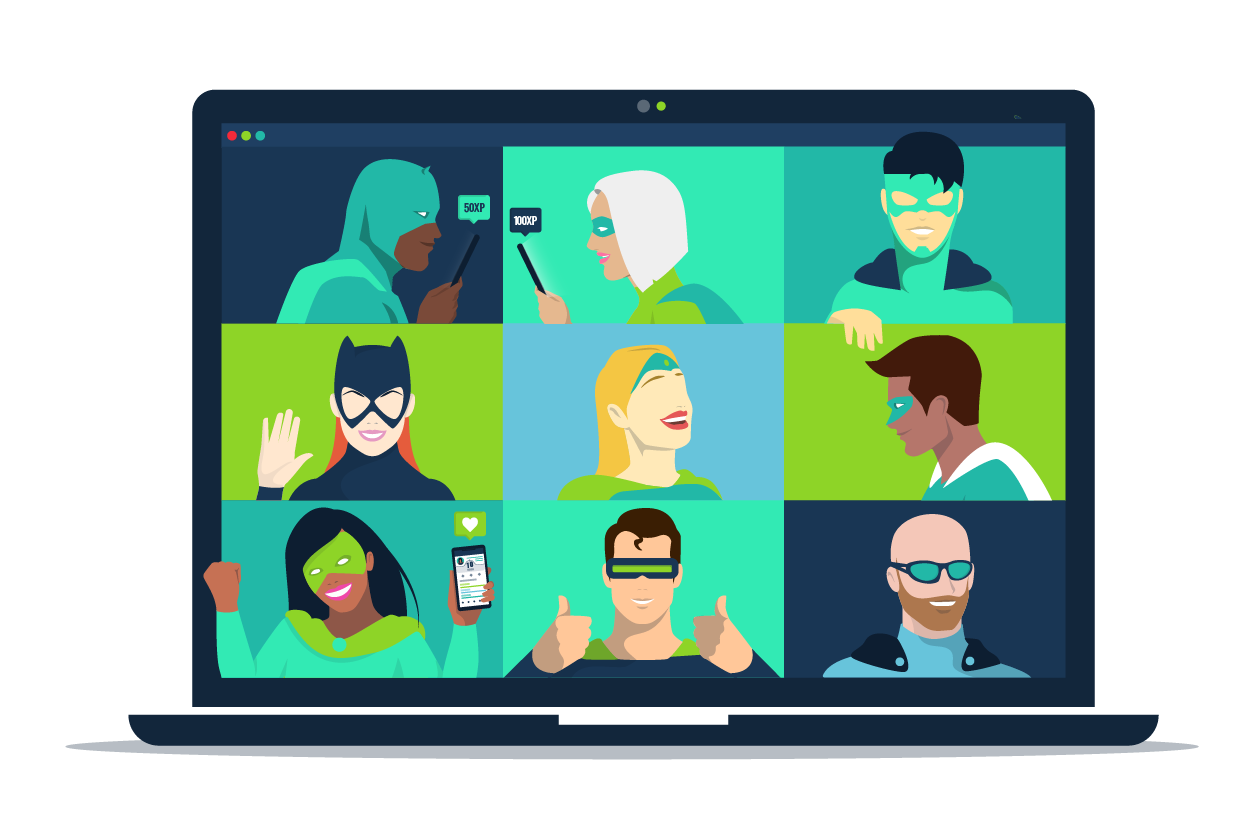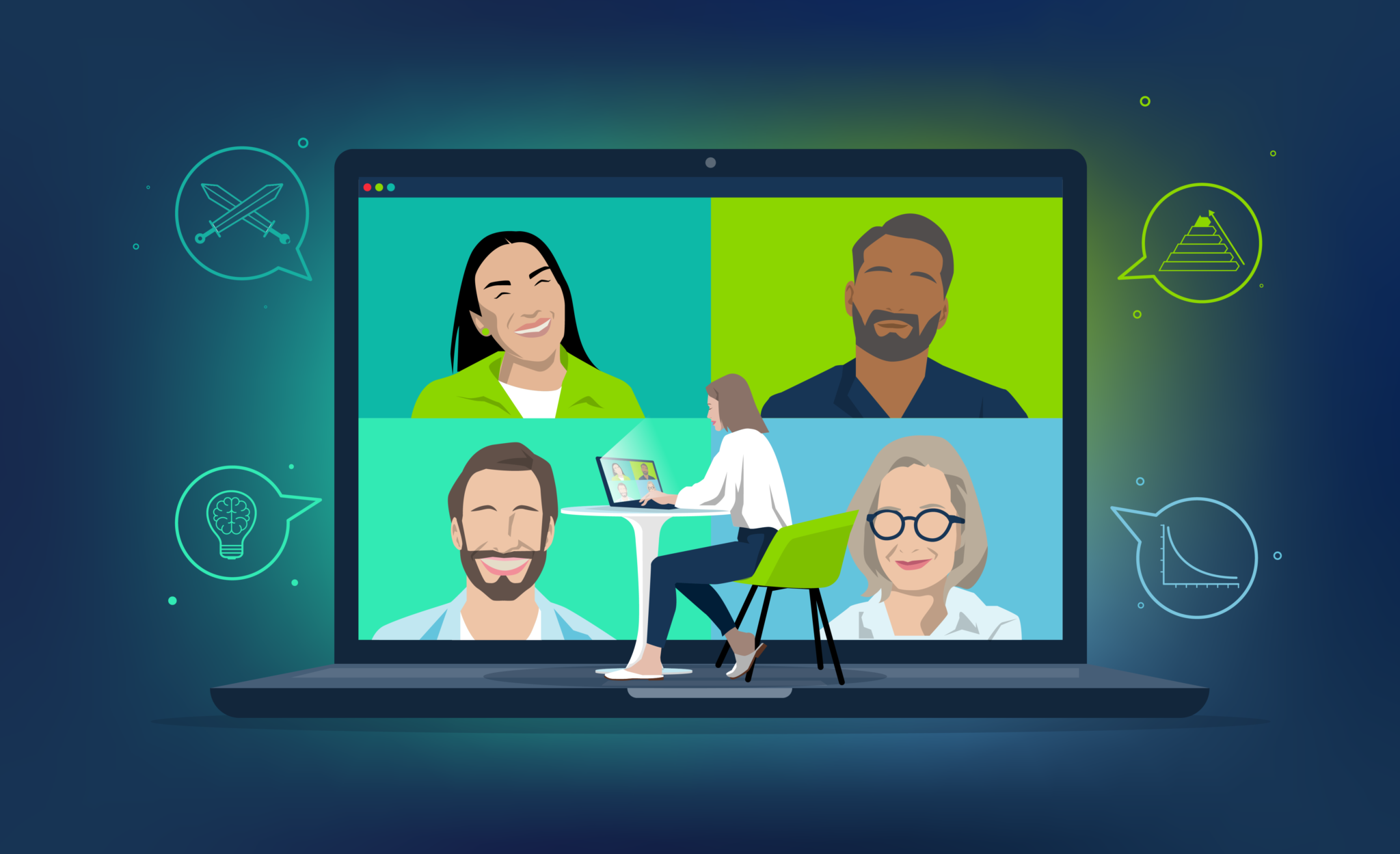In recent years, the working world has undergone a tsunami of change. Remote or hybrid work environments are commonplace and digital transformation is moving at an unprecedented pace. This new digital landscape has given rise to a phenomenon called ‘digital fatigue’. Unfortunately, the world of online training and learning technology is not free from this scourge.
Digital fatigue prevents us from focusing and engaging to the fullest, as our minds work in overdrive to process the overstimulation of fully digital experiences. Considering that the future of training and working looks increasingly hybrid, it’s essential that we find a way to overcome these challenges.
But what does it really mean? And how can educators and L&D professionals aid organisations to prevent digital fatigue?
Let’s have a look!
What Is Digital Fatigue?

Digital fatigue is not a new term. It can be defined as a situation where individuals reach their saturation point of using digital tools. This is often also referred to as ‘digital learning fatigue’, ‘Zoom fatigue’ or simply just ‘online fatigue’. Invariably, it is a stage where individuals experience fatigue that is caused by constantly being plugged in.
Before COVID-19 changed the current working world, digital fatigue was predominant amongst individuals working from home. As such, such exhaustion was not typically common amongst office workers, students or teachers.
Now, when remote and hybrid working are the new norm, more and more people are experiencing digital fatigue. In fact, according to the 2021 Digital Learning Realities survey, 70% of respondents highlight digital fatigue as an issue. This has resulted in more widespread awareness of the term.
What Causes Digital Fatigue?
To fight digital fatigue, you need to understand why such exhaustion occurs and how it affects the individual. Although we all have different tolerance levels, some common causes of digital fatigue include:
- Social inequalities regarding the quality of technology used
- Connectivity issues
- Lower-resolution screens
- Poor sound quality
- Poor-quality imagery
- The feeling of intrusiveness
- The need for constant engagement
- Too many visual and audio stimuli
- Difficulty in setting time and space boundaries
- A sense of overload because of the myriad of online resources
As this list highlights, poor technology exacerbates digital fatigue. Spending hours on end in front of low resolution screens, with bad audio quality and unengaging or overbearing media experiences is a recipe for disaster.
As such, learners may be worried about the quality of their online training while feeling unsure on how to ensure true skills acquisition. After all, learning and working may feel different in a digital format.
These various resources can also lead to sensory overload. Sensory overload happens when your senses give you more input than your brain can process. This overload can lead to extreme irritability and restlessness, which can then lead to total digital fatigue.
In addition, society constantly reminds us of our ever-increasing screen time with articles sharing the issues. Unfortunately, many of us don’t have the choice to switch off. In our digital new normal, we have to spend time in front of screens. Whether that’s for studying, training, working, connecting with friends and family and so on.
Non-Technical Issues
However, technology is only part of the issue. Individuals with premium equipment and good connectivity can still experience a sense of intrusion that leads to digital fatigue.
Remote work makes it more difficult than ever to set boundaries and forget about our ever-lengthening task lists. Perhaps that’s the reason why the average working day has increased to 10.5 hours in the UK, US and Canada.
In addition, digital working or learning can make the individual feel that they are exposed 100% of the time. This does not happen in face-to-face communication situations.
But when we’re online, it feels like we’re being watched, or tracked constantly. This kind of experience can take a huge toll on a person, because of our need for personal space and privacy.
Similarly, what we would consider as natural silences in normal conversation often cause discomfort in a digital setting. This then leads to the feeling that individuals are required to engage at all times. And this, in turn, can lead to digital fatigue.
Symptoms of Digital fatigue

Digital fatigue has been recognised as a concerning condition with significant physical and psychological impact.
Symptoms include (but are not limited to):
- Sore or irritated eyes
- Blurred or double vision
- Pain in neck, spine, shoulders, and wrists
- Increased sensitivity to light
- Sleeplessness
- Lack of concentration
The Impact of Digital Fatigue
Digital fatigue can lead to significant consequences, which can have a big impact on corporate industries and educational institutions alike. This includes (but is not limited to):
- Lack of focus
- Decreased knowledge absorption
- Lower knowledge retention rates
- Disengagement
- Higher student dropout and employee retention rates
- Underdeveloped, unpractised or suppressed social skills
- Stress and anxiety
- Fear of isolation
- Body dysfunctionality related to movement, posture and eyesight
Digital fatigue may eventually lead to a situation of complete burnout. And considering these symptoms, it’s no wonder why more and more people are dreading spending another day in front of their screens.
With this in mind, L&D professionals, HR managers and decision-makers alike need to reinvent their practices to fight the current digital fatigue crisis. One way to do so is to ensure your online training strategies minimise digital fatigue with effective design. After all, no one wants to complete poorly crafted training interventions after a day full of other digital activities.
As such, to prevent digital solutions becoming an enemy, let’s look at some of the best practices to fight digital learning fatigue while using online learning solutions.
Online Learning Design
Instead of embracing the advances of all the technology at your fingertips, you should rethink your design to include elements that make training interventions fun and engaging. In fact, the digital fatigue problem does not lie in the medium, but in a failure to engage creatively within the medium.
As such, you should focus on rethinking the content, processes, and tools that make up your learning experiences. And while the sudden shift to online learning was disruptive, it has opened up opportunities to make learning designs more engaging and impactful.
We are here to share our top tips and tricks. So, let’s explore the different ways how effective eLearning design can help you to overcome the digital learning fatigue that your learners may experience during their online training interventions.
1. Microlearning

A 50-page text dense document is enough to put even the most motivated learners to sleep. We have all been there. After all, these formats are challenging to digest, interpret and work your way through.
Here at Growth Engineering, we believe that small is the new big! Of course, we are referring to microlearning. Microlearning means delivering training in purposefully small units. While there are no official time limitations or rules to what is considered ‘small’, microlearning content typically varies from 5-10 minutes.
These digestible content units make the learning experience more dynamic and stimulating. As learners only have to digest a small amount of information at once, it also makes content comprehension easier.
In fact, microlearning can improve focus and support long-term retention by up to 80%. On top of that, it gives more user flexibility which can be essential when fighting digital learning fatigue.
So, let’s wave goodbye to day-long PowerPoint sessions and embrace magical microlearning experiences.
2. Innovative Content Options
But microlearning content alone might not be enough. After all, one of the main reasons for digital fatigue is the constant use of only one format. This is the case, whether it’s hours spent in Zoom meetings or learning through what feels like endless PDFs.
As such, it’s always a good idea to offer different flavours of learning. Different content formats have different superpowers! Videos, for example, are more memorable and get shared 1200% more than text.
Learning management systems (LMS), like Growth Engineering LMS, let you use a variety of content types to build effective and engaging training plans. This includes everything from presentation slides and PDF documents to videos, audio files and interactive documents.
In addition, you should provide opportunities for user-generated content. This helps you to switch roles with your learners and become a curator, rather than a creator. This can help to engage your learners on a completely different level.
Creating user-generated content is also an effective way to deepen one’s knowledge. In fact, learning by teaching others has been found to be extremely effective.
This is easy to achieve through modern learning technology. Integrating features like social Clubs allow your learners to upload their own content, which can then be used to build and expand your training interventions.
3. Customised Learning Pathways
Imagine sitting behind your computer to complete training that has no relevance to you. Or perhaps the content is too easy or too difficult as the training has not taken into account your current skills or knowledge levels. Frustrating, right?
Simply providing access to learning is not enough. These generalised experiences cannot provide optimised learning outcomes or long-term results. After all, a one-size-fits-all approach tends to leave many by the wayside. And this can accelerate digital fatigue.
Luckily, today’s learning designers are in a position to address this long-standing issue. Organisations need to adopt an approach that takes into account the frequency of training and each person’s specific needs and aspirations.
As such, you must fully understand your learners’ underlying motivations and design your training with the individual learner in mind.
The key to overcoming the issues of one-size-fits-all training lies in customised learning pathways! In fact, personalisation plays a big role in allowing new information to reach the right areas of the brain and be stored effectively.
When learners know they are on the right path, there is no stress about the relevance or usefulness of the content they are completing. Learners can simply launch straight into their training and not waste time searching for the right content.
4. Gamification

As explored, digital learning fatigue does not necessarily only lie in the medium used but in a failure to
engage learners or employees. And that’s why we want to introduce you to gamification!
Here at Growth Engineering, we define gamification as the application of game mechanics to a non-gaming environment to make tasks more engaging. So simply put, gamification can make boring tasks more fun! And who wouldn’t like that?
Gamification utilises mechanics like Experience Points, Badges and Leaderboards. And these features help to create an incentivised learning environment. This helps to engage learners and drives increased participation. But that’s not all! Gamification can improve:
- Performance
- Ability to complete chores and mundane tasks
- Organisational productivity
- Ability to enter ‘flow’ state
- Knowledge retention
- Learner retention
- Communication
Impressive, huh? Studies show that these gamified initiatives can increase engagement by 48%. What’s more, gamification has been demonstrated to boost employee productivity by 90%. It also leads 72% of employees to report feeling motivated to work harder.
5. Social Learning

Catching up with your peers while grabbing some water is an excellent way to get a break. But these physical water cooler moments are not possible while working or learning remotely. In fact, the Gartner Reimagine HR Employee Survey found that 41% of respondents don’t feel connected to colleagues whilst working remotely.
This lack of social contact and increased feelings of isolation can lead to digital fatigue. But that doesn’t mean that your training experiences have to be isolated! You should design your learning interventions with social communication opportunities in mind.
After all, social learning comes with a bounty of benefits. It increases engagement and improves communication and collaboration. Social learning opportunities also help organisations to cultivate a knowledge-sharing culture, which in return boosts business impact.
And did you know, 74% of organisations estimate that a knowledge sharing culture improves productivity by up to 40%? The following features will help you to make this success happen:
- Live Chat is the communication method of choice for learners who long for instant gratification. Live Chat enables easy, immediate connection via instant messages. It provides a safe and private space to discuss issues or interests one-to-one or in groups.
- A Social Feed is an essential part of any informal learning strategy. Learners can express their views, achievements and questions by posting to their Social Feed. Other learners can then ‘like’, comment and reply to the posts.
- Clubs focus on specific topics and can span your entire company or smaller groups and teams. Because Club members have a shared passion, they all have something to contribute. As such, Clubs are the perfect forum for effective knowledge sharing and collaboration.
- The Experts Area helps your learners to find answers to topic-specific issues or queries. You can highlight your subject matter experts by granting them Expert status. So when your team has a question, they know exactly who to go to.
6. Epic Meaning
Learning can be hard work. It requires dedication on the part of your audience. As such, it’s crucial to consider the possibility of digital learning fatigue when designing your learning courses. To produce the best results, learners need to feel that they are more than passive participants.
And that’s where Epic Meaning comes in! Epic Meaning is our desire to do something that matters. As such, an organisation can activate Epic Meaning when it inspires its people and gets them excited about being a part of a bigger purpose.
Learning technology can help you create Epic Meaning, but the only way to activate it is to listen to your learners. As such, you should focus on identifying what their values are and what activities help to fuel their sense of purpose.
And did you know, research shows that 73% of employees who report working for a “purpose-driven” company are engaged? Similarly, your learners will appreciate learning on a platform that oozes Epic Meaning.
‘But how?’ I hear you ask! Creating an engaging online learning platform starts with your company’s mission, goals and values. You should make it clear why your learners’ personal development matters or benefits your wider company mission.
5 Quick Tips for Learners
That’s all well and good. But what if you, as a user, are faced with a poorly designed online learning or digital working environment? We have collected some tips on how you can fight digital learning fatigue regardless!
1. Go Back To The Basics
We know you might have heard the following multiple times before, but your working environment really makes a difference. As such, making sure your room is well-lit, your desk the correct height and your computer settings optimised can help you to fight digital fatigue.
You should also practice good posture and ensure your monitor is placed an arm’s length away. In turn, this will help to keep digital fatigue at arm’s length. After all, this means there is less strain on your eyes and body.

2. Take Care Of Your Well-Being
This is another tip that may sound too obvious. But trust us, early intervention and prevention can reduce the impact of digital fatigue! So, go on those daily walks, remember to stretch every now and then and start adding some physical and eye activity into your daily routine.
And don’t forget to get enough sleep. After all, sleep enables your body to repair and prepare for the next day. This can help you to take care of your mental health.
3. Manage Your Screen Time More Efficiently
We pick up our phones a whopping 58 times a day. On top of that, we are now working and studying remotely, which only adds to our ever-increasing screen time. And while all those funny TikTok dances or cool Instagram feeds are at the tip of your fingers, spending too much time staring at a screen is one of the biggest reasons for digital fatigue.
As such, we recommend managing your screen time and limiting it to essentials. You should start by identifying where your screen time is spent before aligning it to your priorities. You can then see which tasks can be done with an old-fashioned pen and paper.
For example, planning your day or outlining a memo is simple and gives you a much needed break from staring at your screen, while still being effective. In addition, you could try turning off notifications and scheduling screen-free breaks.

4. Interact With Your Peers And Educators
A boring or difficult topic suddenly becomes a lot more interesting and easily digestible when you discuss it with someone else. This also provides you with an opportunity to experience some valuable social interactions. The more you interact and engage, the greater your interest will be in the class or topic at hand.
It’s always beneficial to engage and interact in a virtual classroom session. But don’t limit it there! You can make online learning a lot more fun and collaborative by utilising some of the social learning features integrated into your training programme.
5. Provide Feedback About Your eLearning Design
The transition to remote work and online learning was as sudden for educators as it was for learners. Therefore, you as a learner can assist in supercharging eLearning design by offering useful feedback on your course.
Your feedback could touch on the eLearning content, platform design and its features. It could be positive feedback, or constructive feedback — as long as it’s honest, direct and clearly presented.
Student feedback offers an important source of ideas when it comes to improving eLearning design. In addition, improving engagement and learner interest is easier to achieve when educators get first-hand feedback from learners.
Final Words
Since the quick shift to more digital working worlds and learning environments, digital fatigue has become an unfortunate problem faced by many. And while it seems one of the top buzzwords of today, digital fatigue can have serious physical and mental consequences.
Luckily, there is a lot that can be done! Optimising your online learning design can help you fight digital fatigue by minimising the common causes and symptoms that lead to fatigue.
As mentioned, the digital medium is not the cause. The problem lies with how the medium is typically used. As educators, instructors, trainers and learners alike, we need to do our bit to help fight back against digital fatigue. Are you up to the challenge?
If you would like to find out more about how Growth Engineering can help you overcome or prevent digital fatigue, then get in touch with us today!








